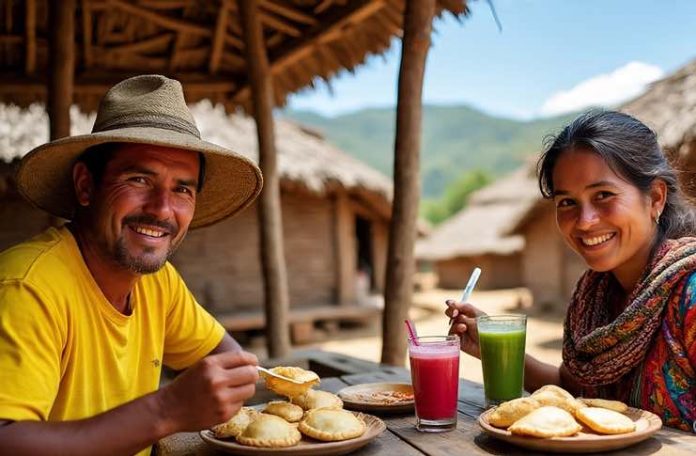Food has always been more than nourishment. It is a living archive of history, migration, creativity, and identity. When paired with travel, food becomes one of the most vivid and immediate ways of connecting with people and places. Beyond taste, the way food is designed, presented, and even the attire of those who prepare it creates a tapestry that speaks volumes about culture. Exploring food culture through travel and culinary design allows us to experience the world in richer and more memorable ways. So as part of our travel blog, let’s delve into it!
Fusion, Tradition, and Evolution: Navigating Culinary Identity
As people travel, cuisines inevitably evolve. Exposure to new flavours and techniques sparks creativity, leading to fusion. Consider Peruvian Nikkei cuisine, a marriage of Japanese precision with Peruvian ingredients, producing dishes like tiradito (a raw fish dish that blends sashimi with citrus marinades). Similarly, Tex-Mex cuisine emerged from the meeting of Mexican food culture with American preferences, producing enduring favourites like fajitas and nachos.
Watch this video to get a glimpse into Peruvian Nikkei cuisine:
Fusion demonstrates adaptability, but alongside innovation, there is also reverence for tradition. Movements like New Nordic cuisine focus on foraging, seasonality, and locality. In Denmark, chefs celebrate ingredients sourced within a short distance, elevating humble roots, herbs, and fish to fine dining status.
This balance, between preserving culinary heritage and embracing new influences, defines food culture. Travel allows us to witness both the grandmother teaching her grandchildren to hand-roll dumplings in China and the avant-garde chef in New York experimenting with edible flowers and molecular gastronomy. Both are equally valid expressions of culture, one grounded in continuity, the other in evolution.
Food as Diplomacy: Breaking Barriers One Bite at a Time
Food is not only personal; it is political. Nations have recognised the value of cuisine as a tool for diplomacy. Culinary diplomacy initiatives aim to spread cultural influence and foster goodwill through national dishes.
Watch this video to learn more:
South Korea, for example, has invested heavily in promoting kimchi and Korean barbecue globally, tying them to its identity as a modern yet tradition-rich nation. Thailand’s government has supported Thai restaurants abroad as a way to boost both tourism and cultural presence. Meanwhile, Mediterranean countries often highlight the health benefits of their diets as part of broader cultural branding.
On an individual level, travellers engaging with local food traditions also practice a form of diplomacy. Each shared meal becomes a cross-cultural dialogue, where curiosity replaces stereotypes and mutual respect is forged through flavour.
Culinary Workwear: Design Meets Functionality Across Cultures
Beyond the food itself, culinary culture extends into the attire of those who prepare it. Culinary workwear is a fascinating aspect of design, balancing functionality, tradition, and identity.
The classic white chef’s jacket, for instance, represents more than cleanliness; it symbolises authority, professionalism, and pride. In many cultures, aprons and uniforms are as much a part of the dining experience as the menu itself. They protect staff, enhance efficiency, and contribute to the overall aesthetic of a restaurant or food stall.
Design innovations in culinary apparel have kept pace with the evolving demands of modern kitchens. Comfort, breathability, and durability are essential for staff working long hours in hot environments, but so too is style, as uniforms often reflect the brand identity of the establishment. In casual dining, uniforms may lean towards vibrant and relaxed styles, while fine dining often calls for elegance and restraint.
For those looking to explore thoughtfully designed apparel, it is worth taking time to visit ChefWear.com official site. Their designs reflect the global nature of today’s culinary industry, combining practicality with creativity for chefs and kitchen staff around the world. This highlights how workwear is a part of culinary culture that ties design and performance together.
Eating the World: Destinations That Inspire the Appetite
Every era has its culinary capitals, and today’s world offers more variety than ever. Cities like Lyon, Istanbul, and Mexico City are celebrated for blending tradition with innovation. Glasgow has recently emerged as a surprising food hub, reinventing itself through artisanal producers and multicultural influences. In Asia, Penang and Seoul have become magnets for travellers seeking both street food authenticity and modern creativity.
Smaller cities and regions are also carving out reputations through their unique food identities. Arequipa in Peru offers a rich heritage of local dishes such as rocoto relleno, while Kigali in Rwanda is attracting attention for its contemporary African cuisine that bridges tradition and cosmopolitan flair.
Food travellers now seek experiences that go beyond simply eating. They want to understand where ingredients are sourced, how dishes are crafted, and the role of food in local customs. Cooking classes, foraging tours, and chef-led dining experiences are becoming integral parts of itineraries. This shift reflects a deeper appreciation for food as a cultural lens, not just a tourist attraction.
Travel, Taste, and Design—A Triad of Cultural Discovery
To explore food culture through travel is to embark on a journey of identity, innovation, and storytelling. Culinary design shapes how we perceive and connect with dishes, while travel provides the canvas on which these experiences unfold. From fusion trends to national culinary diplomacy, from street food vibrancy to the thoughtful design of chef uniforms, food culture is as much about design and experience as it is about flavour.
Every meal shared abroad is both a discovery and an exchange of experiences. By paying attention to not only what we eat but also how it is prepared, presented, and even worn, we come to understand that food culture is one of the most dynamic expressions of humanity. Travel simply gives us the opportunity to savour it all.










 Sarah Knapp is a Brooklyn based entrepreneur whose love for the outdoors and community building led her to the October 2013 creation of OutdoorFest. She has a BA in History, is a Wilderness First Responder and a NY state hiking, camp and boating guide. Her proudest achievement to date is reading the Aeneid in Latin.
Sarah Knapp is a Brooklyn based entrepreneur whose love for the outdoors and community building led her to the October 2013 creation of OutdoorFest. She has a BA in History, is a Wilderness First Responder and a NY state hiking, camp and boating guide. Her proudest achievement to date is reading the Aeneid in Latin.  Allison was one of our first top writers and Chief Editor but is no longer working with offMetro. Allison is a native New Yorker, who has lived in Rome, Tuscany, Melbourne, Toronto and Los Angeles. She frequently contributed travel pieces to Family Travel Forum, using her own children as guinea pigs as they travel the globe. She never missed a chance to sample local delicacies, as her love for travel goes hand-in-hand with her love for food and
Allison was one of our first top writers and Chief Editor but is no longer working with offMetro. Allison is a native New Yorker, who has lived in Rome, Tuscany, Melbourne, Toronto and Los Angeles. She frequently contributed travel pieces to Family Travel Forum, using her own children as guinea pigs as they travel the globe. She never missed a chance to sample local delicacies, as her love for travel goes hand-in-hand with her love for food and  Josh Laskin is a freelance travel writer and photographer based in the White Mountains of New Hampshire. When he is not at work or on the road, you can find him in the mountains snowboarding, climbing, hiking, fly fishing, mountain biking, and eating bagel bites.
Josh Laskin is a freelance travel writer and photographer based in the White Mountains of New Hampshire. When he is not at work or on the road, you can find him in the mountains snowboarding, climbing, hiking, fly fishing, mountain biking, and eating bagel bites. Annie is a travel writer, environmentalist, and surfer based in Venice, CA. She heads up our West Coast team, keeps our grammatical errors in check, and makes sure our California writers always have a plan for their next adventure. Follow Annie’s travels @annelisemcb.
Annie is a travel writer, environmentalist, and surfer based in Venice, CA. She heads up our West Coast team, keeps our grammatical errors in check, and makes sure our California writers always have a plan for their next adventure. Follow Annie’s travels @annelisemcb. Carly Pifer is a freelance writer who has been known to follow whims inspired by romantic movie scenes or colorful street style shots to India, Japan, Tunisia and Argentina. After stints living in Seoul, Boston, Paris and Los Angeles, writing and searching for something intangible, she landed somewhat steadily in Brooklyn and has begun to find inspiration in her more immediate surroundings.
Carly Pifer is a freelance writer who has been known to follow whims inspired by romantic movie scenes or colorful street style shots to India, Japan, Tunisia and Argentina. After stints living in Seoul, Boston, Paris and Los Angeles, writing and searching for something intangible, she landed somewhat steadily in Brooklyn and has begun to find inspiration in her more immediate surroundings.  Kate E. O’Hara is a New York based freelance writer and photographer who loves all things food—especially the people who make it and market it. Her writing aims to capture the essence of the food experience; the stories that go well beyond a plate of ingredients. In addition to her love of food, Kate is also known to have a hankering for red wine and craft beer. You can also find Kate on Instagram
Kate E. O’Hara is a New York based freelance writer and photographer who loves all things food—especially the people who make it and market it. Her writing aims to capture the essence of the food experience; the stories that go well beyond a plate of ingredients. In addition to her love of food, Kate is also known to have a hankering for red wine and craft beer. You can also find Kate on Instagram